The Naval War College put on the truly historical Jutland game – using a version of the actual 1916 war College rules. Over at the Naval Undersea Warfare Center, as the kickoff game in our Historic Naval Battles series, we put on a more “Beer and Pretzels” version. Soft pretzels were actually available from the Subway next to the “collaboration center” we used to hold the game. Usually used as a classroom for 40+ people – this space had maybe 20 x 50 ft of usable floor space, allowing the use of a 300yds per inch and 8 turns per hour game scale.
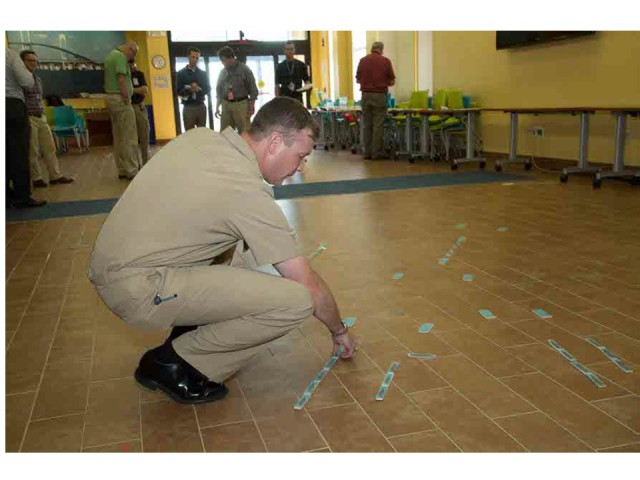
We had NUWC’s Chief Staff Officer CDR Pete Rodgers playing the role of ADM Scheer leading the High Seas Fleet. John Ackerman, one of our resident Engineer gamers, took the role of Jellico. We had about 15 players all told, each commanding a squadron of 4-8 capital ships and/or light ship formations. A lesson learned in hindsight from Pete Pelligrino over at NWC, was to give players a “Forward” command and a “Rear” command – this would have avoided the unfortunate circumstance that half the players took most of the game getting to the battle. Despite only having the opportunity to get a few licks in (if any) before we reached out collective culmination point – about 3 hours of game play following an hour of setup and rules explanation – the proverbial good time was had by all.
We used graphics from the out of print Jutland game blown up to about 4 inches long. That gave about a 1/2400 scale top down view and at the same time, at 1200 yds ground scale, took up about 600ft of ship with 500yrds for and aft. So a line of ships had 1000yds spacing – a bit far perhaps, but not bad.
The counter dimensions were driven by the choice to use 3/16s balsa (which came in 4 in widths and 3ft lengths) for bases to which the ship graphics were affixed to with “mod-page” fixative. This worked out really well resulting in ships that were easily handled, with the advantage of being able to record hits and torpedo salvo use with ball-tipped stick pins stuck into the balsa bases
The light cruiser and destroyer formations were similarly 1200 yrds long, but about 600 yrds wide – a bit tight for typical 2-3 CLs and 4-5 DDs, but not terrible given the limit of the number of pieces of balsa stock available at the local Micheal’s craft store. They were the source of all the other materials or the game ringing in at under $40 using a 30% off coupon courtesy of my daughter the master crafter of the family! We used pipe cleaners bent into the desired path of ship movement to give orders and facilitate the movement of the ships along on the floor. To represent the time delays associated with command and control of the period, the players “gave orders” for the next turn, ten executed orders for this turn. This was a bit problematic when quarters became close – as it became difficult to avoid fudging by players who put their “orders” out after others. If we had it to be done other, we would have just had the players draw the desired pass on a yellow sticky placed near the formation. The rules have been updated to reflect that. Using white pipe-cleaners gave a nice impression of “wakes” when seen from a distance – though also in reverse as the pipe-cleaners were placed out ahead of the counters as “orders” as well.
We used pipe cleaners bent into the desired path of ship movement to give orders and facilitate the movement of the ships along on the floor. To represent the time delays associated with command and control of the period, the players “gave orders” for the next turn, ten executed orders for this turn. This was a bit problematic when quarters became close – as it became difficult to avoid fudging by players who put their “orders” out after others. If we had it to be done other, we would have just had the players draw the desired pass on a yellow sticky placed near the formation. The rules have been updated to reflect that. Using white pipe-cleaners gave a nice impression of “wakes” when seen from a distance – though also in reverse as the pipe-cleaners were placed out ahead of the counters as “orders” as well.
 In typical fashion we used range sticks, but as Home Depot apparently no longer make dowels longer than 3ft, Michaels came through with a bundle of decorative bamboo rods, a bit under half an inch in diameter and about 80in (24,000 scale yards) long. These worked perfectly – light weight and just stiff enough not to bend when held out. With range marks every 10 inches to 50in and every 5 after that (as effectiveness dropped off and negative DRMs to fire quickly accrue) it was quick and easier to judge distances.
In typical fashion we used range sticks, but as Home Depot apparently no longer make dowels longer than 3ft, Michaels came through with a bundle of decorative bamboo rods, a bit under half an inch in diameter and about 80in (24,000 scale yards) long. These worked perfectly – light weight and just stiff enough not to bend when held out. With range marks every 10 inches to 50in and every 5 after that (as effectiveness dropped off and negative DRMs to fire quickly accrue) it was quick and easier to judge distances.
 The intention was to use cotton both for “laid smoke” and “firing smoke” but it was apparent that indicating smoke for every firing would delay things far more than it was worth, so that was cast aside and stricken from the rules. To keep things moving, each squadron fired together at an enemy squadron, totaling the firepower points from the Jutland counters. Each firepower point amounted to a roll of a d10 – with a “0” (10) required for a hit. Learning my lesson from the Okinawa game – with typical squadron firepower factors in excess of 20 to over 30 – I made a firepower table that aggregated the distribution of expected results and reduced any firing to a single d10. I stole the idea from the SPI Dreadnought game that “off the table” (i.e. greater than 9) results dramatically escalated hits – while “less than 0” rolls (typically at long range) dropped rapidly to zero.
The intention was to use cotton both for “laid smoke” and “firing smoke” but it was apparent that indicating smoke for every firing would delay things far more than it was worth, so that was cast aside and stricken from the rules. To keep things moving, each squadron fired together at an enemy squadron, totaling the firepower points from the Jutland counters. Each firepower point amounted to a roll of a d10 – with a “0” (10) required for a hit. Learning my lesson from the Okinawa game – with typical squadron firepower factors in excess of 20 to over 30 – I made a firepower table that aggregated the distribution of expected results and reduced any firing to a single d10. I stole the idea from the SPI Dreadnought game that “off the table” (i.e. greater than 9) results dramatically escalated hits – while “less than 0” rolls (typically at long range) dropped rapidly to zero.
This wide range of variation for a given firepower range depending on DRMs was a stark contrast to the NWC 1916 rules were fire did set amounts of damage with no die roll. Both have advantages and disadvantages the historical pedigree of the NWC rules being a perfect match for a scholarly recreation. For “beer and pretzel” gaming I thought a wide range from “something’s wrong with our bloody ships” to “finding the range on the first shot”. Indeed, there were several “runs of luck” each way at critical points in the battle that saw that saw players letting their virtual captains what they thought in no uncertain terms.
 Or matter-of-factly pointing out “oh look, I rolled ANOTHER 9” (Its gotta be the uniform!)
Or matter-of-factly pointing out “oh look, I rolled ANOTHER 9” (Its gotta be the uniform!)
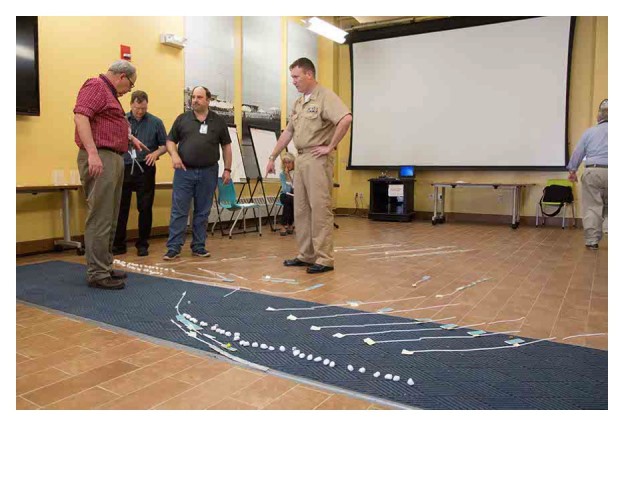 Damage was indicated with stickpins (those with a yellow ball end were cheapest…) and an orange “belch of flame” to indicate “took damage this turn” for later DRMs. Battle cruier vulnerability to big gun fire was taken into acaount with a special die roll when a BC was hit and fired in the same turn. Germans exploded on snake eyes, while the more vulnerable British did so on a 2 or 3. Demonstrating the historical accuracy of the rules, 2 British BCs exploded, right on cue (though one was already little more than a hole in the ocean when it did so). This was indicated with a small pile of belched flame.
Damage was indicated with stickpins (those with a yellow ball end were cheapest…) and an orange “belch of flame” to indicate “took damage this turn” for later DRMs. Battle cruier vulnerability to big gun fire was taken into acaount with a special die roll when a BC was hit and fired in the same turn. Germans exploded on snake eyes, while the more vulnerable British did so on a 2 or 3. Demonstrating the historical accuracy of the rules, 2 British BCs exploded, right on cue (though one was already little more than a hole in the ocean when it did so). This was indicated with a small pile of belched flame.
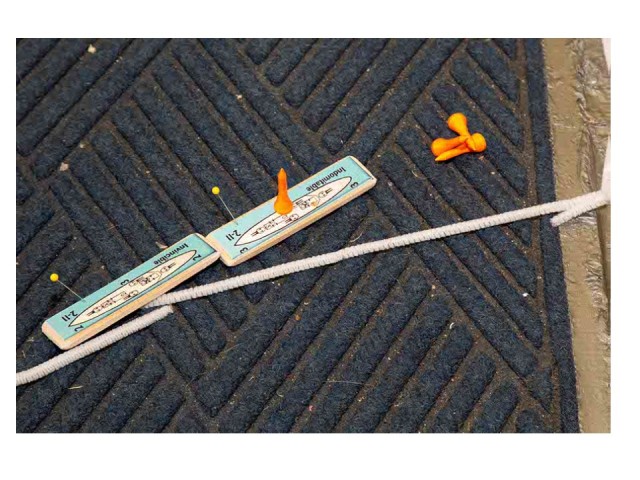 (Yes this was the result of one of those “9”s…)
(Yes this was the result of one of those “9”s…)
All told we made good progress getting through the entire Battlecruiser engagement and a few shots from the main bodies at long range) 14 turns or a an hour and 45min in 3 hours of game play. I made the rookie umpiring mistake of not letting the players do more of their own combat resolution. No matter how much you say you are not – its always SOOOO easy to get drawn in when the action gets hot and heavy and the players get competitive and want an “authoritative” ruling!
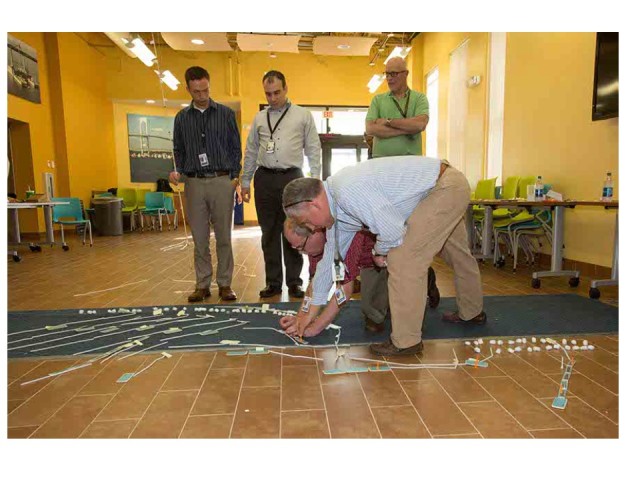 “No, I think its really half an inch closer so I get the +2 DRM for range less than 6yds, don’t you?”
“No, I think its really half an inch closer so I get the +2 DRM for range less than 6yds, don’t you?”
The Destroyers and Light cruisers of the Battle Cruiser force lay smoke and the Heavies speed around it to engage at close range. The German destroyer force uses the smoke to cover a quick approach and use the smoke to cover a turn of its own to break contact and speed toward the Main Body of he Grand Fleet and delay it.
Meanwhile the High Seas Fleet deliberately closes. In hindsight had they closed at full speed they might have gotten their licks in on the British Battle Cruisers. The swirling battle of flank and out-flank almost resulted in a “180” flipping the field.The British Light Cruiser squadrons and DD’s lay smoke for the Battle Cruisers (who survived) to retire behind.
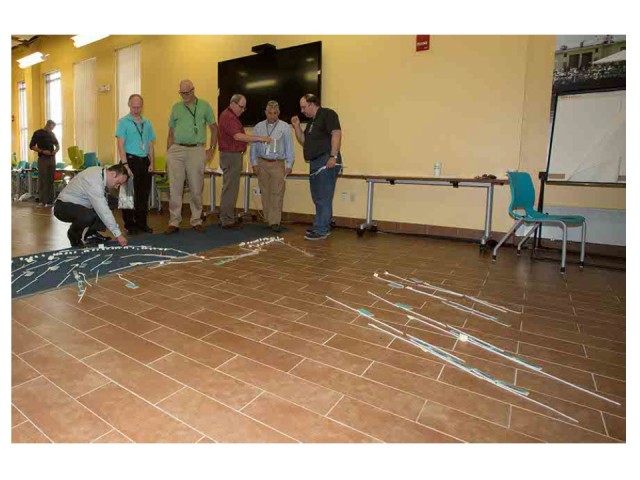
Meanwhile the British Armored Cruisers and 5th Battle Squadron hot their heels, stress test their boilers to get o the fray. It gets orders to heave hard to starboard to meet the German Destroyers when they emerge from behind the smoke.
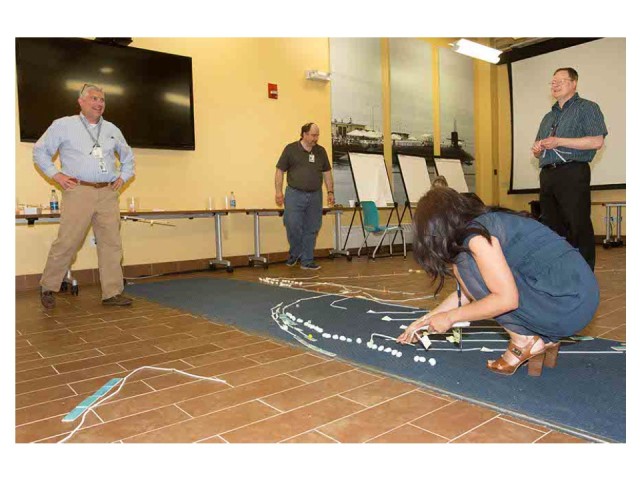
Our photographer had to leave about that time, the battle went on about another 30 minutes after that, the result ending up pretty much as you would expect – the British battle cruisers got mauled – 2 exploded and 2 others lost, but the Germans lost a lot of destroyers in the process of torpedo attacks to finis them off. The British armored cruisers came around the smoke screen as it dissipates and ran right into the line of German pre-dreadnoughts. Neither had the firepower to do a lot , but German torpedobooten got some lucky licks in and forced the British to turn away. The Pre-dreadnoughts were than mauled themselves by the British Light Cruisers. The High Seas Fleet then approached, formed a massive line and headed to the right in the above picture. The Grand fleet was approaching in 4 columns, and started to mass that direction as well. The German Destroyers continued to the right, but the High Seas fleet doubled back to the left (the smoke was gone by then).
As the game ended it was looking like a near run thing whether the High Sea Fleet maneuver would have been able to race around and get past the Grand Fleet before it could be brought to battle or darkness fell. The remaining British Battle cruisers and Light Cruiser squadrons, together with the 5th Battle Squadron had a decent chance of intercepting, but could it have taken the pounding of going against the entire German Fleet? Would the Brits have succumbed to the temptation to throw their individual Battle Squadrons piecemeal to attrite the Germans – risking defeat in detail themselves?
The debate was not resolved!
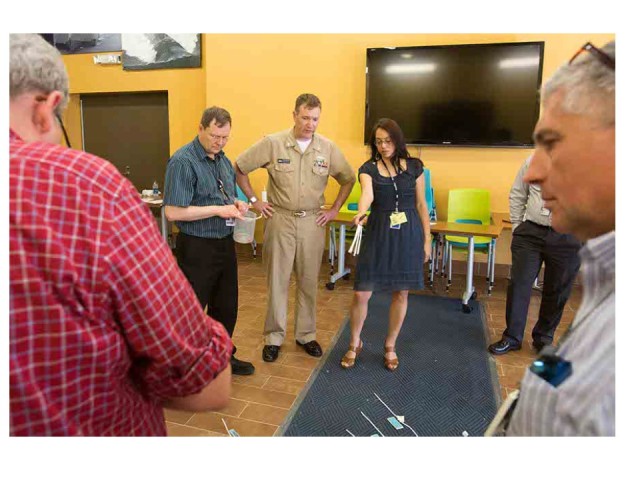
In case you missed the link in the midst of the above, the “print and play” package of rules and graphics is available here. Note that the graphics are from the out of print Avalon Hill Jutland game – copyrighted material at one point, but I’m not sure who owns copyright. They are used here without profit for educational purposes.

Jealousy is a terrible thing!
Did anyone post something recently about a replay of Midway? I swear I saw something but don’t know where. I was asked to write about it in my next column for Yaah! Magazine.
Take care
Peter
Sent with Good (www.good.com)
________________________________
Sorry Peter! I did not hear anything. Pete Pelligrino often does his “cocktail party” version. Not sure if he did it this year. Next year is 75 for Midway, so should be something big over at NWC!
Thanks for the after-action report. I would have loved to have been there.
My thanks as well; would have loved to participate!
The Naval Undersea Warfare Center and NWC Jutland games looked great. We did our own here in the UK at the University of York back in May. Details here: https://www.york.ac.uk/news-and-events/events/public-lectures/summer-2016/battle-of-jutland/ using the old Dunnigan Jutland game rules from 1967 covering both the battle-cruiser and fleet actions, with pretty historical results. I can probably dig outsome photographs if anybody is interested. This was timed to coincide with the publication of a couple of articles on Jutland and Dogger Bank by my colleagues. I understand there is to be a public Jutland game at the Leeds Armouries in November. I must try to get to that.
Fantastic replay .. still hanging on to a “what if/could be” ending
Time seems to be the only real enemy 😉
Thank you for sharing the Rules I will simply have to re-fight Jutland 🙂